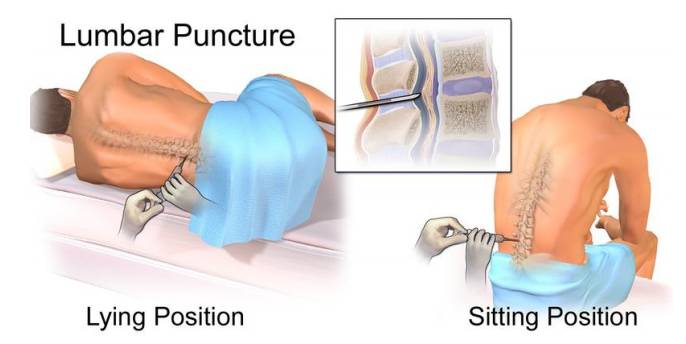Lumbar Puncture information
Please note, this page is printable by selecting the normal print options on your computer.
Lumbar puncture is a procedure performed in hospitals to look for meningitis, small brain bleeds and other neurological disorders. It is needed as brain scans and other tests sometimes cannot tell if these conditions are present. The test enables Doctors to take a sample of fluid known as cerebrospinal fluid (CSF) which circulates continuously between the brain and spinal cord. The procedure is generally safe and the Doctor who does the procedure will have received training in this procedure.
Your Doctor will discuss with you if the procedure is needed. The procedure will be described to you and you will be asked to sign a consent form afterwards to have the procedure done. You may refuse the procedure and discuss alternative approaches. The procedure will usually be done on the hospital ward. It takes around fifteen minutes. Care is taken to avoid infection with anti-septic scrub (patient should warn doctor if they have an allergy to the local anaesthetic used or antiseptics).Sterile paper drapes, a sterile gown and sterile gloves are used. It can be done with you sitting up or lying on your side. Lying on one side is in general preferred to allow routine measurement of the pressure of spinal fluid.
It can however be done sitting up and this is the preference of some doctors. Once the Doctor has prepared things for the lumbar puncture he/she will inject some local anaesthetic into the small of your back. This may feel like a ‘bee sting’. After a few minutes the Doctor will inject more anaesthetic deeper into the back tissues. The Doctor will check the anaesthetic has worked and that the area is numb before proceeding. A very fine needle will then be passed into the space below the end of the spinal cord to take a fluid sample.
Although local anaesthetic is used you may however continue to feel some sensations. Occasionally you may have more discomfort or sharp sensations that may travel down the leg or into the groin. If this happens let the Doctor know immediately and he will change his approach and may inject more local anaesthetic before checking with you that you are happy for him/her to proceed further.
Once the needle is in the right place the Doctor will take a pressure measurement of the fluid and then collect samples to send to the laboratory. After the procedure you will be asked to lie flat for 1-2 hours. Some results will be available within a few hours. Some tests on the fluid may take several days or occasionally longer. Lumbar puncture is a safe and very useful test. However as with any test complications can occur.
These include:
- Discomfort from the procedure. Let the doctor know immediately if you are uncomfortable or experience pain. He/she can change the approach, use more local anaesthetic or stop the procedure if necessary. Any pain after the procedure should settle with paracetamol or ibuprofen and go completely after a day or two. If it does not please let a doctor know.
- The doctor may not be able to get a sample. He may ask, with your consent, a different doctor to try such as an anaesthetist, or a doctor who can use X-rays to guide the needle.
- There is also a risk of bleeding. (Please be sure to let the doctor know if you are receiving blood thinning treatment before the procedure).
- The needle may also come into contact with nerve roots and this may cause electrical pains down the leg. These pains should settle if the needle is repositioned so please let the doctor know if you experience discomfort during the procedure.
- Very occasionally infection may occur after the procedure. A spinal infection could develop and result in paralysis. This is very rare (0.3/10000 – 1.8/10000 cases)
Sometimes fluid may leak from the lumbar puncture. This can cause a headache that is worse when standing and is called a low-pressure headache (risk is about 15-20%). This is usually mild-moderate in severity and should settle after a few days with rest. If it does not then let a doctor know. Sometimes a simple procedure is needed to stop it if it persists.

Sometimes a Doctor will be learning the procedure but if this is the case you will be made aware of it and you will be asked for your consent for this Doctor to do the procedure. In addition they will be supervised at all times by an experienced Doctor).
